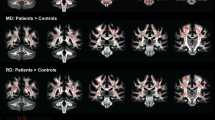Abstract
We studied six patients in the early stage of Huntington's disease, together with six unaffected normal subjects. Localized spectra were acquired from 4-ml voxels encompassing the combined putamen and caudate head using STEAM with TR=1 s and TE=40 ms. Metabolite concentrations were calculated using tissue water as an internal reference. Although MRI showed minor degenerative changes in the basal ganglia, we were unable to detect any differences in the neuronal marker,N-acetylaspartate, between the two groups (patient mean ± SD, 10.7±2.1 µmol g wet wt−1; controls 11.4±1.3). Similarly, we were unable to detect differences in either choline or creatine. In contrast to other studies, we were unable to detect any increase in lactate content of the basal ganglia in these patients with early stage disease. We conclude that proton MR spectroscopy will not be a suitable technique to detect the very early changes in asymptomatic patients identified as having the mutation.
Similar content being viewed by others
References
Shoulson I, Fehn S (1979) Huntington's Disease: clinical care and evaluation.Neurology 29 1–3.
Warner JP, Barron LH, Brock DJH (1993) A new polymerase chain reaction (PCR) assay for the trinucleotide repeat that is unstable and expanded on Huntington's disease chromosomes.Mol. Cell Probes 7 235–239.
Barker PB, Soher BJ, Blackband SJ, Chatham JC, Mathews VP, Bryan RN (1993) Quantitation of proton NMR spectra of the human brain usingtissue water as an internal concentration reference.NMR Biomed 6 89–94.
Jenkins BG, Koroshetz WJ, Beal MF et al. (1993) Assessment of energy metabolism defects in Huntington's disease using31P and1 H localized spectroscopy and functional MRI. Possible therapy with coenzyme Q10.Proc Soc Mag Res Med p. 134.
Urenjak J, Williams SR, Gadian DG et al. (1993) Proton nuclear magnetic resonance spectroscopy unambiguously identifies different neural cell types.J Neurosci 13 981–989.
Brownell A-L, Hamberg LM, Hantraye P et al. (1992) Combined assessment of blood volume, flow and glucose utilization in a primate model of Huntington's disease.Proc Soc Mag Reson Med p. 510.
Parker WD, Boyson SJ, Luder AS et al. (1990) Evidence for a defect in NADH: Ubiquinone oxidoreductase (complex I) in Huntington's disease.Neurology 40 1231–1234.
Author information
Authors and Affiliations
Rights and permissions
About this article
Cite this article
Lowry, M., Quarrell, O., Turnbull, L.W. et al. Proton MRS studies in Huntington's disease. MAGMA 2, 357–359 (1994). https://doi.org/10.1007/BF01705271
Issue Date:
DOI: https://doi.org/10.1007/BF01705271




